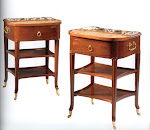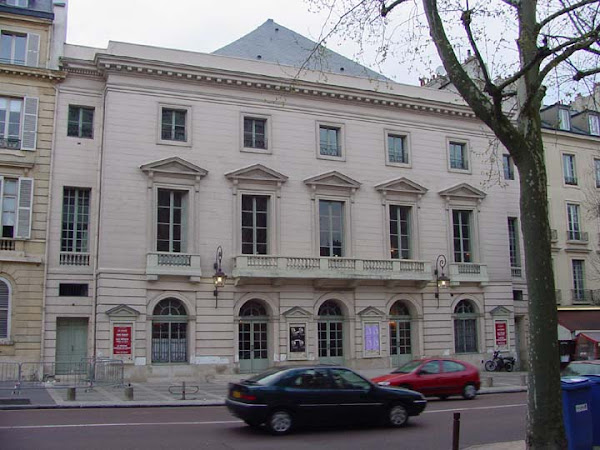Samuel Bernard represented the emerging class of men of commerce that were the true beneficiaries of the reign of Le Roi Soleil and as this cast of businessmen, financiers and fermiers generaux of the Ancien Régime began to progressively gather power and influence in the 18th Century, they often commissioned fine Hôtels in Paris that rivaled the residences of the older and socially superior noblesse d'épée.
His son, Samuel-Jacques Bernard (1686-1753) , later Comte de Coubert after inheriting from his father, was fortunate enough to be born in to a great fortune. This allowed him to ally himself to the better pedigreed noblesse d'épée by marrying the daughter of of Le Marquis de La Coste by which means he procured a property and eventually joined two houses on the rue du Bac and the rue Saint-Dominique and the architect entrusted with taking the two houses and giving them a proper remodeling was François Debias-Aubry who engaged a master wood carver Jean Martin Pelletier to execute the boiseries. Below is a surviving plan of this house of which nothing survives as it fell victim to the ambitious remaking of Paris directed by Baron Haussman during the reign of Napoleon III in the Second Empire Period.
The house was sold after the death of Samuel-Jacques Bernard in 1753 by 1761. Its succeeding resident and owner was another financier, Pierre Pierre Tavenier de Boullongnne.
The historic significance and admirable quality of the boiserie paneling and remaining contents was already appreciated by many before the demolition of the house and these elements were sold in 1887.
This was so, even before the public sale of the contents of the house long after the death of Tavanier de Boullogne in the early 1790's. As the demolition of the house approached, Baron Edmond de Rothchild (1845-1934) bought the panels of the grand salon de compagnie before the remaining boiseries and appointments were sold to the public.
The boiseries of this grand salon de compagnie were later installed in Baron Edmond's Paris residence at 47 Faubourg St Honoré. They remained there until 1969. This is a photo of Baron Edmond below.
The panels of sumptuously carved and gilded boiseries from this historic salon de compagnie were donated in the late 1960's by Baron Edmond's grandson to the new Israel Museum in Jerusalem. The room was opened to the public in May of 1969 to great fanfare and the installation was entrusted to one of the great personages of the world of aristocratic decorating, Henri Samuel. As is also widely known, It was to Henri Samuel that the munificent donors to the Metropolitan Museum in New York City, Charles and Jayne Wrightsman, entrusted with the similar supervision of the installation of a breathtaking suite of period French 18th Century rooms much admired today as The Wrightsman Galleries.
In the December 1969 issue of Connaissance des Arts magazine, an article was written by Marcelle Berre de Turique celebrating the new installation. At the time, without the benefit of today's more updated scholarship which later shed more light on the room's history and original configuration, the room was hailed as a masterpiece of historical authenticity and a perfect representation of a Louis XV period salon de compagnie which the article also incorrectly believed to be by Germain Bouffrand. It cited the presence of no less superb furniture such as the large bureau plat in the centre of the room attributed to Pierre Migeon, the ravishing Porcelain de Saxe inkstand resting upon it, the luxurious suite of seating furniture covered in fine needlepoint, the pair of portraits, the large Beauvais tapestries and the large scale marble statue of Diana the Huntress which had a provenance of having come from the royal gardens of Marly. All this was cited to show the correctness and authenticity of this installation reputed to recreate a salon in which Voltaire and Madame de Pompadour would have felt at home. See the five illustrations below from that article.
The reality is entirely different. No one who loves the joie de vivre of the French 18th Century would argue the room is not ravishing and of great interest. But, like just about any American museum "period room" (with the exception of the admirable Salon Doré recently restored at the Palace of the Legion of Honour Museum in San Francisco), it's not quite an authentic recreation. On a good day, it's an assembled group of lovely representative French 18th Century decorative art in a room of boiseries carved in the mid 18th Century and vastly changed by the time it got to Israel to the point that its original owner would be very bewildered and disoriented! Years after the article cited above appeared and claimed my notice, the late Bruno Pons, in his landmark book French Period Rooms shared his research that established the architect was not Bouffrand and that the room was significantly altered to suit Baron Edmond de Rothchild, and later the museum under Henri Samuel's supervision. This is how the room appeared in Bruno Pons' book. With slight tweaking it's not too different today when this essay was written in late 2016.
In the mid 18th Century, a salon de compagnie would have been for a reception or gatherings to play card games or tric trac. The seating `a la reine with flat backs would have been formally arranged around the wall and seldom removed from there. While the less formal curved backed seating en cabriolet would have been used in the center of the room and used around the gaming tables. Console tables with marble tops were part of the original furnishings as well. The currently displayed console tables are adequate substitutes however. Tapestries were not customary either. More mirrored panels would have been part of the original ensemble. Pons' research also established how the doors which now flank the short walls would have been in the corners. The current corner panels would have flanked the mantle piece!
The original cornice was once a tour de force of carving and gilding and long ago lost. A pretty but repetitive cornice was installed under Henri Samuel's direction.
There would have been no bureau plat. It was not a study. And while no one will deny, that to an early 21st century visitor, the large marble figure of Diana adds fetching note of panache as a decorative addition, it would have been an inconceivable addition to drag in a statue from the garden into a grand salon de compagnie of the Ancien Régime! And while the room has some lovely Sevres porcelain as well, the factory didn't exist when Bernard commissioned the room and no Sevres porcelain is cited having been in the room in an extensive inventory taken after his death in 1753.
In the Pons publication the dessus-de-porte paintings are also discussed. This is the finest one below depicting an allegory of Asia. It was painted by Carle Van Loo and is clearly the best of the set of four such over door paintings depicting the 4 corners of the world which also had panels representing Africa and America by Jacques Dumont le Romain as well as another panel representing Europe by Jean Restout.
These are some more recent images that show the latest arrangements of the salon with the bureau plat in a different position and the canapé that was not seen in the earlier images. Note the incorrect placement of seating `a la reine in the centre of the room around the bureau plat...
...While on the wall on the right seen in the photo below, from which the room is entered to be visited with a barrier, in between the windows and doors, there are a pair of Louis XV canapés with curved backs against the walls... Of course they would have not been anywhere except the centre of the room in the 18th Century if they would have been placed in the room at all!
For a young Israeli student of the decorative arts seeking to see good examples of the French decorative arts of this period it's a very good start until such a student can get to see more examples in Paris and Versailles. However as a decorative ensemble, like the Wrightsman Galleries, it's just a gathering of superb and representative items in one room that only manages to evoke and fails to authentically recreate a grand salon de compagnie of mid 18th Century Paris in which the works of the great writers of the French Enlightenment would have been a plausible subject of discussion along with the latest gossip from the Court of Versailles!

































